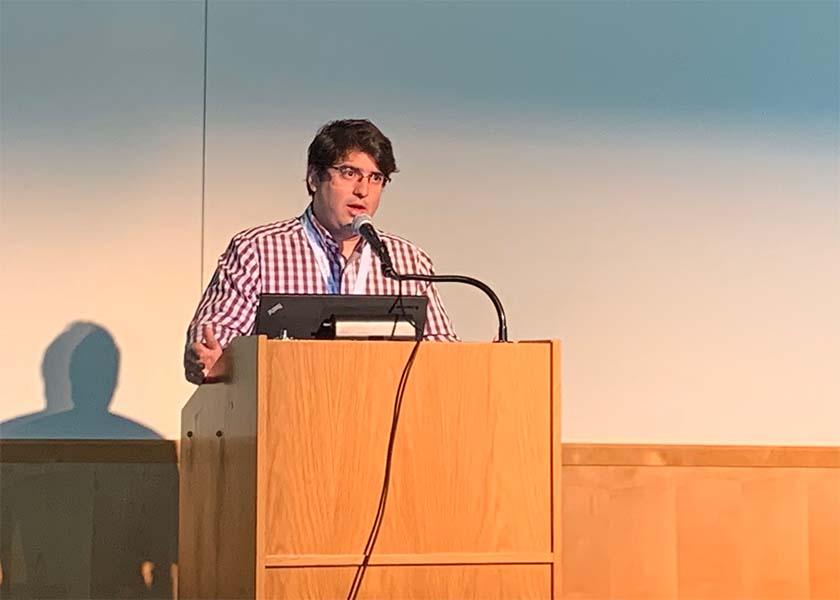Pigs, People and Influenza: How Does Management Come Into Play?

Swine influenza A virus (IAV) is a formidable opponent in swine herds across the country. It cunningly finds ways to adapt and change. Its high mutation rate and the co-circulation of multiple strains make IAV control complicated at best.
Research shows indirect transmission of influenza is important to consider as well as management practices that can facilitate IAV transmission between litters, said Gustavo Lopez-Moreno, a PhD student at the University of Minnesota, in “Pig and People Management Practices to Wean Influenza Negative Pigs” during the Carlos Pijoan SDEC Symposium at the Leman Swine Conference on Sept. 19.
In a series of three research studies, Lopez and his colleagues narrowed the knowledge gaps on what management practices are necessary to prevent the spread of influenza during the pre-weaning period and to better understand the main sources responsible for transmission.
How Does Internal Biosecurity Impact IAV at Weaning?
In his first study, Lopez evaluated three IAV-positive and non-vaccinated sow farms to assess the internal biosecurity practices on IAV prevalence at weaning, the association between IAV antibody levels and IAV status at weaning, and detection of IAV in hands of farm workers and tools used for piglet handling.
He took 120 litters on each farm and stratified litter selection within parities. Treatments were assigned at the room level. Through a series of sow nasal swabs, sow udder skin wipes, air samples, piglet nasal swabs and serum, and hands and tools sampling, he evaluated a combination of samples from parturition to day 18 and tested with RT-PCR and IDEXX ELISA tests.
Lopez said they implemented internal biosecurity practices aimed to reduce influenza exposure to newborn piglets. These practices included no pig movement between litters after processing, no adoption of piglets (nurse sows), no holding back piglets past their wean age to gain weight and changing gloves between litters when handling.
The results revealed internal biosecurity practices delayed influenza infections but were not sufficient to result in negative pigs at weaning, Lopez said.
“We discovered that sows at farrowing were not a main source of influenza to piglets and piglets with higher MDA levels had lower likelihood of testing IAV positive,” he said.
IAV Contamination and Farm Activities
During the second study, Lopez looked at associations between farm activities prior to weaning with IAV contamination of farm workers performing those activities.
“We wanted to know if certain interventions were more likely to result in contamination of farm workers that then could spread influenza,” Lopez said. “This included handling of pigs at processing, vaccination or the weaning process. We also wanted to know if hands and clothes were a source of influenza infection to pigs.”
Processing, vaccination and weaning are the activities that involve most piglet handling, he said. During the study, workers were provided new coveralls and gloves before beginning each activity. Samples were collected after the activity was accomplished using wipes.
Lopez discovered piglet vaccination and weaning procedures were the activities associated with higher risk of IAV contamination of workers performing the activities. Both farm workers’ hands and coveralls resulted in high contamination rates of IAV as a result of the activities performed. Finally, viable virus was found on coveralls and gloves after both vaccination and the weaning process.
“We were interested in that difference because few farms have protocols in place after these activities,” Lopez said. “Washing hands between activities is a practice on some farms, but not changing clothes.”
A Combination Approach
In the third study, Lopez combined the evaluation of internal biosecurity measures with sow vaccination to determine the impact on weaning influenza-negative piglets.
“We know vaccination can reduce IAV prevalence, but fails at weaning IAV negative piglets consistently. We know management practices can delay IAV infections during lactation, but prevalence at weaning was not altered. We know those two by themselves were not good enough. So, what if we put them together?” he asked.
Using six IAV-positive breeding herds, Lopez assigned five herds to the vaccination plus internal biosecurity practices treatment, and one was assigned as a control to account for the seasonality of IAV, Lopez said.
Each sampling points consisted of 30 udder skin wipes and air particle deposition samples from weaning sows/rooms during weeks 1-3 and 12-14. Mass vaccination with an autogenous vaccine with the circulating IAV strain in the herds was administered at weeks 3 and 6.
Enhanced biosecurity practices were enacted between weeks 6 to 13. These practices included no cross fostering of pigs after processing, all handling of pigs required changing gloves between litters, plastic boot covers used if personnel needed to enter the crates, no nurse sows, and farm workers segregated in “blocks” depending on piglets’ age.
Three of the five farms became IAV negative quickly – they also happened to have a lower IAV prevalence before intervention. Farm B became negative towards the end of the study and remains negative today. Farm A continues to be IAV positive, he said.
“Internal biosecurity practices and vaccination alone are not sufficient to consistently wean negative pigs, both are needed,” Lopez said. “Chances of success increase as prevalence decreases because there are less sources for contamination of materials and hands/coveralls.”
He added that mechanical transmission by contaminated materials and farm workers needs to be taken into consideration, too.
“Management practices to reduce exposure of influenza to newborn piglets in combination with vaccination is needed to wean influenza negative piglets,” Lopez said.
Read More From Farm Journal's PORK:
8 Quotes to Remember from Day One of the Leman Swine Conference
Ohio State University Student Takes Home Morrison Swine Innovator Prize







